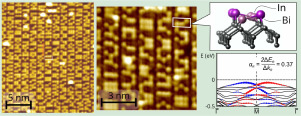当前位置:
X-MOL 学术
›
Surf. Sci.
›
论文详情
Our official English website, www.x-mol.net, welcomes your
feedback! (Note: you will need to create a separate account there.)
The array of In-Bi heterodimers on the Si(100) surface
Surface Science ( IF 2.1 ) Pub Date : 2020-04-01 , DOI: 10.1016/j.susc.2019.121557 D.V. Gruznev , A.N. Mihalyuk , L.V. Bondarenko , A.Y. Tupchaya , A.A. Yakovlev , O.V. Kropachev , A.V. Zotov , A.A. Saranin
Surface Science ( IF 2.1 ) Pub Date : 2020-04-01 , DOI: 10.1016/j.susc.2019.121557 D.V. Gruznev , A.N. Mihalyuk , L.V. Bondarenko , A.Y. Tupchaya , A.A. Yakovlev , O.V. Kropachev , A.V. Zotov , A.A. Saranin

|
Abstract Studying the In and Bi coadsorption onto the Si(100) surface at elevated temperatures using Scanning Tunneling Microscopy, Angle-Resolved Photoelectron Spectroscopy, and Density Functional Theory, we have found the formation of a 2 × 4 array of In-Bi heterogeneous dimers. The surface is closely related to a Bi-induced Si(100)2 × n-Bi ( n = 5 − 12 ) reconstruction and can be visualized as that with one Bi atom in a Bi-Bi dimer replaced by In atom, and the length of dimer rows stabilized on 4 periods. The In-Bi dimers are buckled, with Bi atoms being 0.62 A higher than In. STM simulations revealed that the contribution of a Bi atom into experimental STM contrast is dominant. The asymmetric In-Bi heterodimers orient in a unit cell independent of each other producing chaotically looking STM images despite the 2 × 4 lattice itself is well-ordered. The surface is semiconductor featuring noticeable Rashba-type spin-splitting of surface states. This structure is believed to be an interesting object for theoretical and experimental studies on the influence of lack of symmetry and chemical disorder to spin polarization in the low-dimensional materials.
中文翻译:

Si(100) 表面上的 In-Bi 异二聚体阵列
摘要 使用扫描隧道显微镜、角分辨光电子能谱和密度泛函理论研究高温下 Si(100) 表面的 In 和 Bi 共吸附,我们发现形成了 2 × 4 阵列的 In-Bi 异质二聚体. 该表面与 Bi 诱导的 Si(100)2 × n-Bi ( n = 5 − 12 ) 重建密切相关,可以想象为 Bi-Bi 二聚体中的一个 Bi 原子被 In 原子取代,并且二聚体行的长度稳定在 4 个时期。In-Bi 二聚体是弯曲的,Bi 原子比 In 高 0.62 A。STM 模拟表明,Bi 原子对实验 STM 对比度的贡献占主导地位。尽管 2 × 4 晶格本身是有序的,但不对称的 In-Bi 异二聚体在彼此独立的晶胞中定向,产生看起来很混乱的 STM 图像。表面是半导体,具有明显的表面状态 Rashba 型自旋分裂。这种结构被认为是关于缺乏对称性和化学无序对低维材料中自旋极化的影响的理论和实验研究的有趣对象。
更新日期:2020-04-01
中文翻译:

Si(100) 表面上的 In-Bi 异二聚体阵列
摘要 使用扫描隧道显微镜、角分辨光电子能谱和密度泛函理论研究高温下 Si(100) 表面的 In 和 Bi 共吸附,我们发现形成了 2 × 4 阵列的 In-Bi 异质二聚体. 该表面与 Bi 诱导的 Si(100)2 × n-Bi ( n = 5 − 12 ) 重建密切相关,可以想象为 Bi-Bi 二聚体中的一个 Bi 原子被 In 原子取代,并且二聚体行的长度稳定在 4 个时期。In-Bi 二聚体是弯曲的,Bi 原子比 In 高 0.62 A。STM 模拟表明,Bi 原子对实验 STM 对比度的贡献占主导地位。尽管 2 × 4 晶格本身是有序的,但不对称的 In-Bi 异二聚体在彼此独立的晶胞中定向,产生看起来很混乱的 STM 图像。表面是半导体,具有明显的表面状态 Rashba 型自旋分裂。这种结构被认为是关于缺乏对称性和化学无序对低维材料中自旋极化的影响的理论和实验研究的有趣对象。











































 京公网安备 11010802027423号
京公网安备 11010802027423号